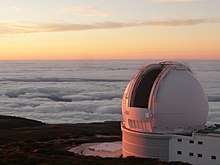Grubb Parsons
Sir Howard Grubb, Parsons and Co. Ltd. was a telescope manufacturer, more commonly known as Grubb Parsons. It was based in Newcastle upon Tyne, in England.

They were a noted telescope maker throughout the 19th and 20th century, making telescope throughout the World and some of the largest British telescopes, including one of their final projects, the William Herschel Telescope in the 1980s.
In the late 1800s they were one of the few companies that could make large doublet objective lenses
History


The company was founded in Dublin by Thomas Grubb as the Grubb Telescope Company in 1833.[1] Thomas Grubb was joined in 1864 by his son Howard who built on the company's reputation for quality optical instruments. Grubb was also known for building accurate electrically driven clock drives for equatorial mounted telescopes.
The technology for doublets was not so easy to come by, Grubb purchased this technology from the maker Guinand in 1838, who ten years later would go to work from Grubb during the 1848 revolution, according to History of Astronomy: An Encyclopedia.[2]
Some of the telescopes produced in the 19th century include the Great Melbourne Telescope, a 48-inch-diameter (1.2 m) reflecting telescope with speculum primary mirror, the 27-inch refractor for the Vienna Observatory (1878), the 10-inch refractor at Armagh Observatory (1882), the 28-inch refractor at the Royal Observatory, Greenwich (1893), which is the UK's largest refractor, and the 10-inch refractor at Coats Observatory, Paisley (1898). In 1887 Grubb's firm built seven normal astrographs for the Carte du Ciel international photographic star catalogue project, 13 inch refracting telescopes all designed to produce uniform photographic plates.
In 1925 the company was acquired by Sir Charles Parsons and renamed.[3] The company traded until 1985,[1] designing and building the optical components for telescopes such as the Anglo-Australian Telescope, UK Infrared Telescope, Isaac Newton Telescope[4] and the William Herschel Telescope,[1] all of which are important astronomical instruments currently in use.[5]
A partial history of the company was written by its last managing director, George M. Sisson.[6]
See also
References
- Backyard Voyager Page 1 Archived 2011-07-07 at the Wayback Machine
- Lankford, John (2013-03-07). History of Astronomy: An Encyclopedia. Routledge. ISBN 9781136508349.
- Backyard Voyager Page 2 Archived 2009-04-28 at the Wayback Machine
- Armstrong, Simon; Bayman, Hannah (11 January 2014). "When Geordies reached for the stars". BBC News.
- Astronomy Knowledge Base Archived 2006-07-05 at the Wayback Machine
- Sisson, G.M. (1992). "Mirror Images". Vistas in Astronomy. 35: 345. Bibcode:1992VA.....35..345S. doi:10.1016/0083-6656(92)90001-m.
External links
- Durham University Grubb Parson Lectures
- Former Grubb Parsons large mirror polishing machine
- Grubb and Parsons: Optical and engineering giants
- Grubb Parsons telescope construction photos
- List of telescopes made by Grubb Parsons with some references, compiled by I.S. Glass
- The 36-inch telescope at Cambridge University
- Tyne & Wear Archives: Location of surviving records of Grubb Parsons